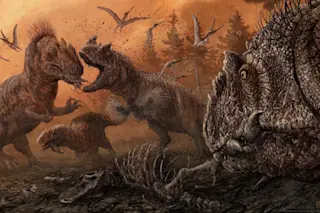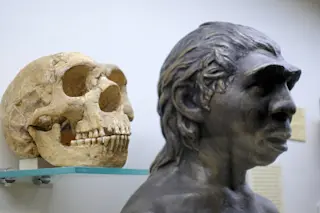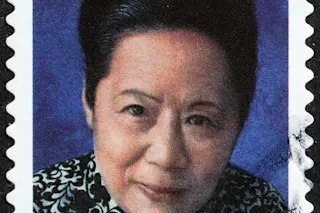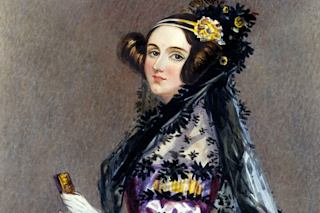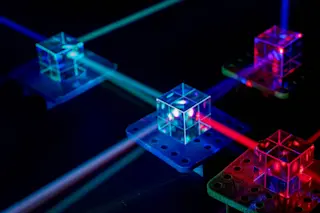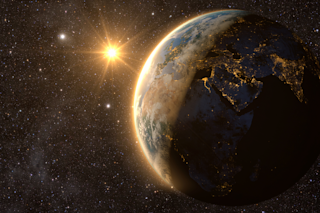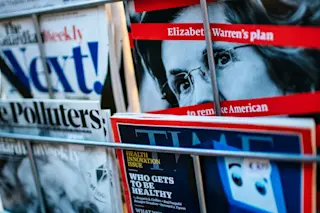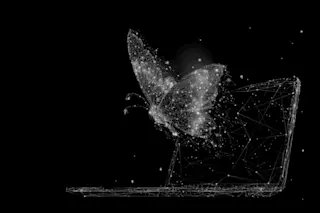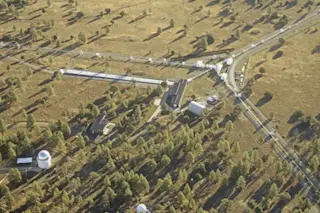Meet the true stars of the movie Passengers: the starship Avalon, with its plasma-shield generator sticking out like a stinger, and robot bartender Arthur, played by Michael Sheen (here with Chris Pratt). Credit: 2016 Columbia Pictures Industries By now you've probably seen those soulful faces staring out at you from the ads for the new movie Passengers: Jennifer Lawrence and Chris Pratt playing Aurora Land and Jim Preston, two would-be interplanetary colonists who wake up from hibernation way, way too early. They drive the film's plot and bestow the whole project with a glowy, Hollywood-blockbuster sheen. But the film's real stars are less familiar, less visible, and distinctly more intriguing. One of the standout characters is Arthur, a robotic bartender played with Turing Test verve by Welsh actor Michael Sheen. The other is the ship itself: the Avalon, an automated interstellar cruise liner bringing 5,000 settlers to a new world...assuming they arrive intact. Arthur and the Avalon explore well-worn ideas about space exploration, machine autonomy, and artificial intelligence in fresh and engaging ways. As a result, there is a lot more to Passengers than meets the eye. What is most striking about both Arthur and the Avalon is how much thought went into them. I spoke with Michael Sheen and Passengers director Morten Tyldum to find out about how they brought their visions of future technology to the screen. Tyldum, who previously directed the Alan Turing film The Imitation Game, clearly has been doing a lot of pondering about AI and the limits of computing. He also wanted to get the technical details of spaceflight plausibly correct, so his Avalon is restricted to Einstein-approved, slower-than-light travel. And he filled Passengers with sly homages to Stanley Kubrick: not just the expected 2001 but also the Kubrick-inspired AI: Artificial Intelligence and, more surprising, The Shining. But enough of me. Let's hear directly from Michael Sheen and Morten Tyldum. (Warning: There are some mild spoilers ahead.) First off, Michael Sheen.How do you find inspiration for playing a robot? Michael Sheen: With this role there were two major elements. One is that there is a tradition on film of the British-accented robot on a spaceship who may or may not fuck things up for everybody. We were playing off that tradition, being aware of that. But on the other hand, we were starting from the point of view of, what is the function of this robot, what was he created to do? He was programmed to be the best bartender in the world…or in space.
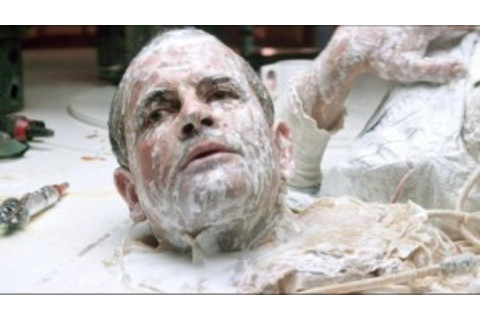
Science fiction movies are not always kind to the British-accented robots--here, Ash from Alien. (Credit: 20th Century Fox) Morten and I talked about what does that mean. Arthur has been programmed to anticipate the needs of his customers. Because of what happens in our story, Arthur, who is designed to meet the needs of thousands of people, finds himself trying to anticipate the needs of one very particular person in very particular circumstances. The thing that Jim (Chris Pratt) needs more than anything is another human being. In trying to meet the needs of Jim, Arthur is trying to be more human. That pushes his programming into an area that it wasn’t really designed to do. Arthur is starting to go into areas of his memory banks and improvisation with customers that is completely new territory for him. How do you portray the inner life of a character who is not actually alive? Sheen: This is something that’s been explored before, of course. I was thinking about Pinocchio wanting to become a real boy. In Arthur’s attempt to go into areas he’s not designed to go into, inevitably it starts to create a version of an inner life. That is interesting in all kinds of ways. He tries to learn, tries to learn what is a joke and why is it a joke. He tries to help that in a very complicated situation—to keep two opposing ideas or concepts in mind at the same time without resolving them. It’s something robots are not designed to do, and inevitably it makes him seem more human. Then the moments when it becomes absolutely clear that he is not human, like when Jim slaps him across the face, that becomes more shocking.
One thing that makes Arthur extra unsettling is his resemblance to the bartender in The Shining. That was deliberate, I assume?
Sheen: Absolutely! The bar is based on the bar in The Shining, same carpet that’s in the hallways in The Shining but with the colors inverted, and my costume is based on Lloyd the barman’s costume, the bartender in the Overlook Hotel. It’s similar to the idea that audiences are familiar with the characters of Ian Holm in Alien or Michael Fassbinder in Prometheus or HAL in 2001—this tradition of robotic servants that have a hidden agenda that is against the human wishes. That’s baggage that anyone will bring to this, and that’s something we wanted to play with. Ultimately, Arthur is not like that, but he still manages to create massive difficulties for everyone. Where does your interest in science fiction and artificial intelligence come from? Sheen: Science fiction is probably my favorite genre. One of my favorite writers is Philip K Dick. When I did a production of Hamlet a few years back it was very influenced by Dick. One of his obsessions is characters who begin to suspect the version of reality they have come to accept has something else behind it, a different version of reality. Hamlet is a play that has as one of its obsessions a character who constantly talks about what is real and what only seems to be real—the first soliloquy is all about that. And a character who is an unreliable narrator who is constantly questioning what is going on around him. That was my way into the play. What is your own attitude toward robotics and AI? Sheen: One of the greatest challenges to our culture right now is automation. We’ve seen how that is affecting the loss of manufacturing jobs, and how globalization is affecting things politically across the whole of the West. With increasing automation, that’s going to put more and more pressure on these things. The big question is, just because you can do something does that mean you have to do it? Can we as a civilization have the conversation about whether all progress is worthwhile or whether we need not to open certain doors? That’s a big conversation to have.
Your character in Passengers suggests another kind of future-tech question: Would you want some aspect of your brain uploaded to a computer? Would you want that kind of immortality?
Sheen: I don’t think so. What defines being alive is the certainty of death. To become immortal would be to give up what my definition of humanity is. It is only through the experience of suffering that you can empathize with anyone else’s suffering. The ultimate suffering is to lose one’s life, or to lose someone. There’s something that feels very right and beautiful about knowing that everything is transient. In the words of Queen, who wants to live forever?
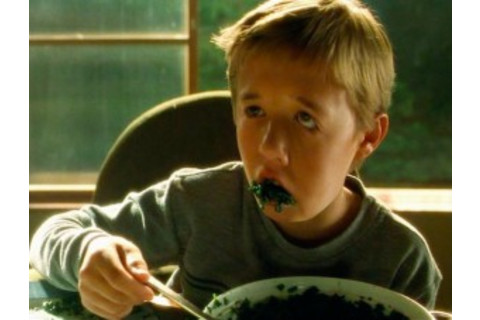
Can an object become alive? AI: Artificial Intelligence raised this question (and so did Pinocchio). Credit: Warner Brothers. You had to be partly mechanical to play the role of Arthur. How did that affect your performance? Sheen: I was put in a special rig. There was a kind of bicycle seat I sat on and my knees went into these padded areas and there was a rod that my back was attached to. That rig was on a system of tracks, and its movements were logged into a computer. The rig was a sophisticated, brilliant piece of machinery, but not the most comfortable thing. Then I had to integrate the computerized movements so that it seemed like it was coming from me rather than of from the outside. The more I felt like I was in charge of those movements, the more it helped me get in character. Or…maybe I am actually a computer that you are talking to. If so, I’ve passed the Turing Test! I am a real boy! Next, my conversation with Morten Tyldum:
How much did the design of your spaceship, the Avalon, shape the overall movie?
Morten Tyldum: The ship is really the film's third main character. We spent so much time designing it…it’s every filmmaker’s dream to create a spaceship. There are so many iconic spaceships—the Millennium Falcon, the Nostromo, the Enterprise. I wanted the Avalon to be a part of that. It has so many different sections; we went forward in time and backward in time when we designed it. We used modern architecture, but also backward to art deco and art nouveau. The ship also is a source of dark humor. It wakes up when humans are present and tries to help, but it’s not aware of the predicament of the humans who woke up too early. It is oblivious to what is going on.
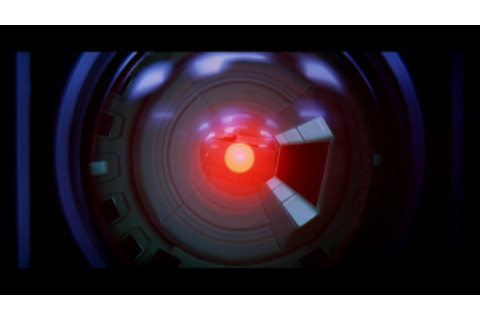
Hal 9000, ancestor of so many morally conflicted movie machines. (Credit: YouTube) Arthur the bartender lives in the uncanny valley, real enough to relate to the other characters yet in some ways as inhuman as the ship. How did you conceive this character? Tyldum: I thought about this a lot while working on the Alan Turing movie. The Imitation Game is all about the question, if a machine can imitate life is it alive? If I think you’re alive, does that mean you are alive? It’s a very interesting debate, and it was fun to play with it. Michael Sheen had great insight into a delicate character—there’s something comforting about him, but also something very unnerving. The Shining references were there partly for those reasons, and partly as a tribute. In some ways Passengers is a story about a couple that ends up in divorce, and Arthur becomes the child they have shared custody over. That’s something that science fiction can do very well: take human relationships or parts of our society and put them in a very different setting where you can look at them with new eyes. You can look at this as a story about a marriage: you have the lies and deception, you have forgiveness, love, redemption, heartbreak…you have all of that.
The Avalon incorporates a lot of subtle technical details, more than the plot really requires. Were you inspired by the 100 Year Starship and other scientific studies of space travel?
Tyldum: We did a lot of research for the film. We wanted everything on the ship to be there for a reason, not because it was fun. Every part of the ship moves 51 meters per second, which creates 1 g acceleration. The speed we see the ship moving onscreen, that is the actual speed it’s rotating. A ship like that moving through space needs a protective shield against rocks and particles. We created a plasma shield, something in the front that would protect the ship but not like in Star Trek, which is just magic almost. The Avalon has an engine that provides propulsion but also moves energy to the shield—both from the same source, one goes forward, one goes back. It was interesting to do all these technically defined things first and then shape the ship to make it emotional, with symbolic value. I wanted to evoke the big immigrant ships that went between Europe and the New World during the time of the big immigrations, when Europeans came to America and Canada. We used elements of a big cruise ship, with the upper class and lower class and the luxury parts. You even sketched out the economics of interstellar travel, which is rather unusual. Tyldum: The whole business idea of the company that runs the ship is that they want passengers to spend as much money as possible over the four months they are [awake] onboard. They have to spend future money, not Earth money, so when you land on the planet you are already in debt to the company that owns the planet. That in many ways how real immigration was; when the immigrants came over they already had debt that they had to work off. All of those ideas we brought in to the way the ship was built. You can eat for free in the cafeteria, but then you want to go to these restaurants that cost money. You can spend as much as you want, but when the bill comes you have to work it off on the planet. Not all of that had to be in the movie, but it was so fun to create all these rules of how the world worked.
[spoilers] Passengers also wrestles with issues of survival, but never addresses whether the stranded couple would or should have children to carry on after them, in the style of a multi-generational starship. What do you think?
Tyldum: That was a huge discussion, and on purpose we left it vague. We want people to discuss that. Would you have raised kids there? The passengers made the choice to be on that ship, but to bring children into that life, then they’d be 70-some years old when the ship arrived—is that something you would have done? When people walk out of this movie, I hope they will discuss it.



